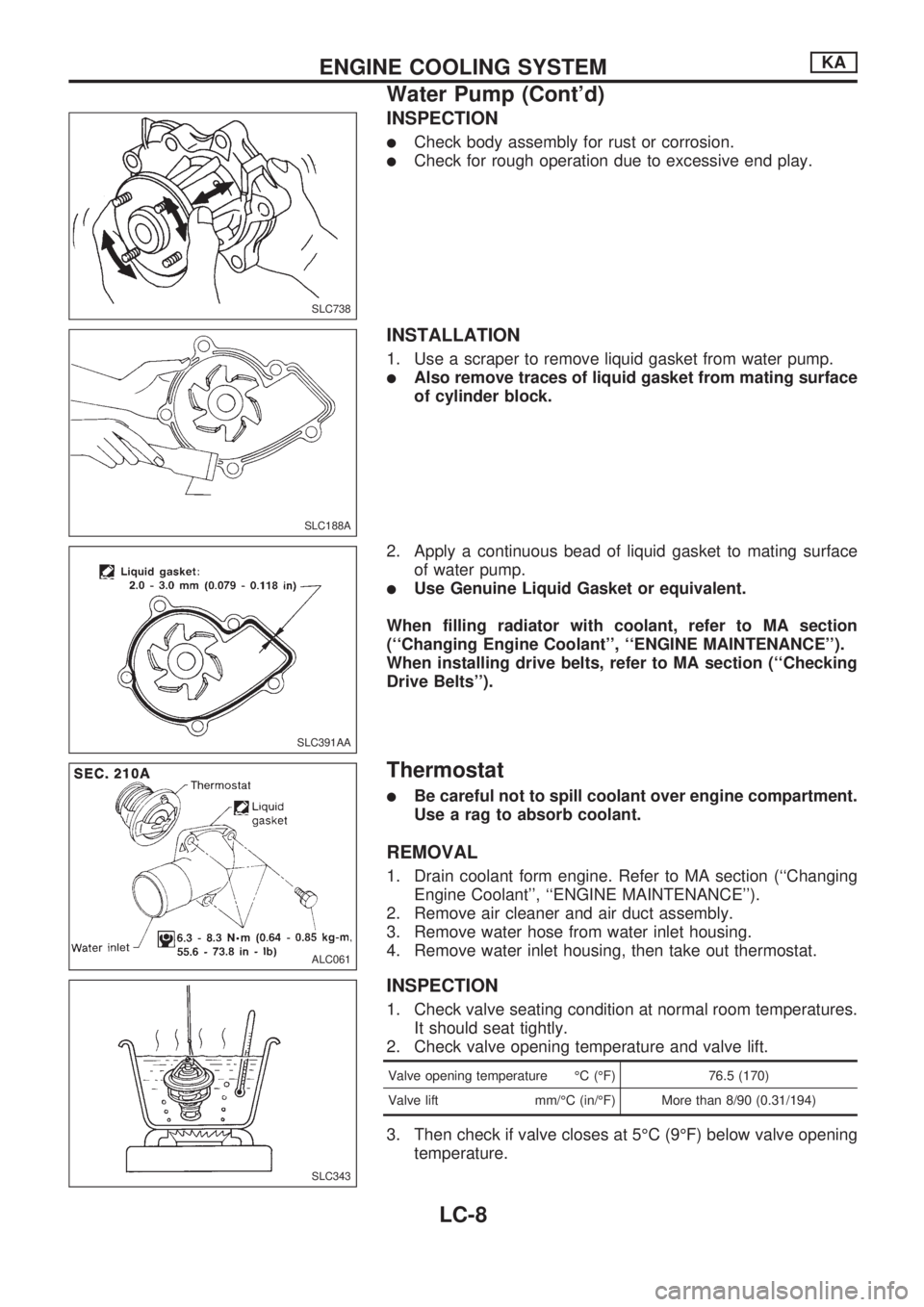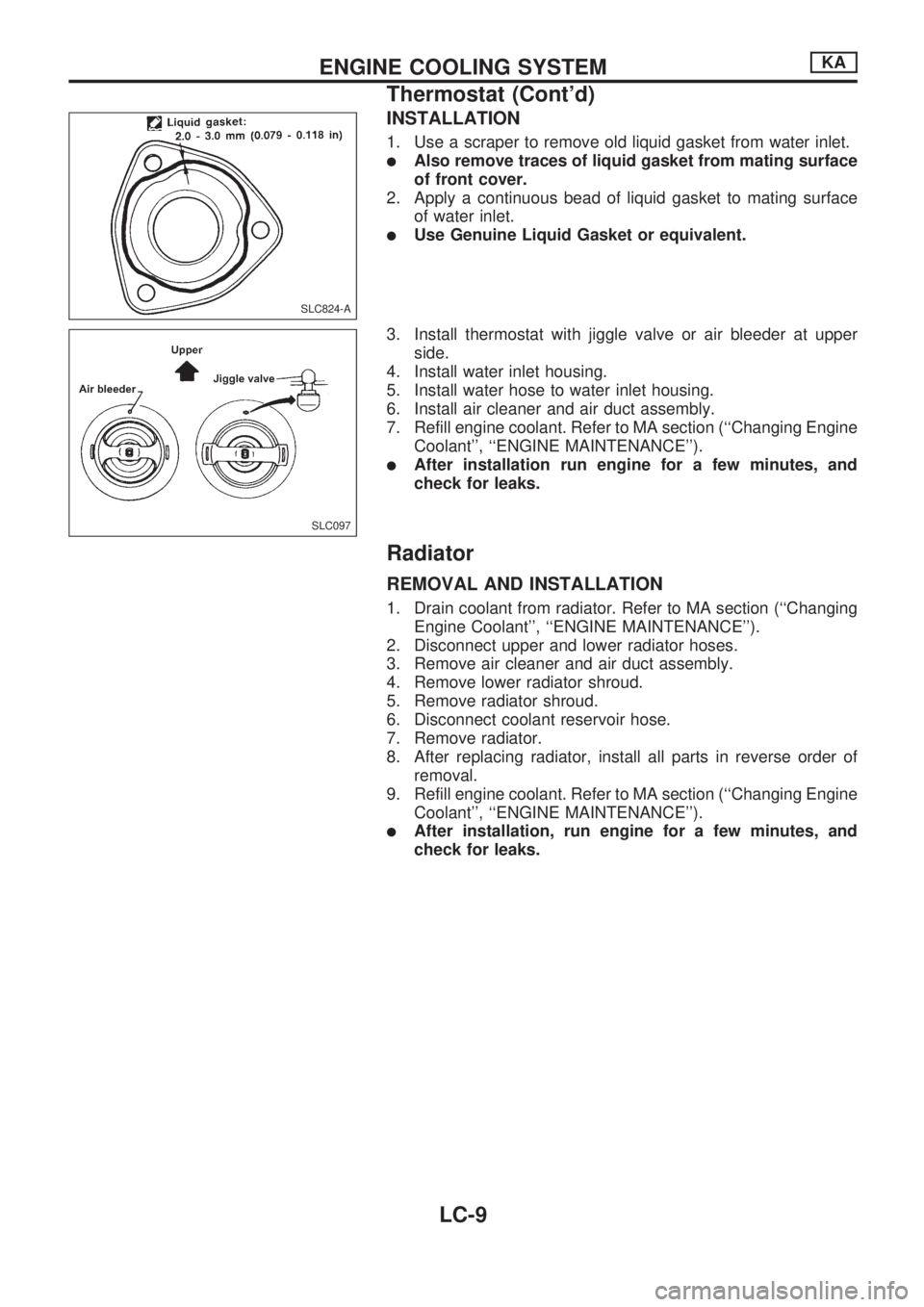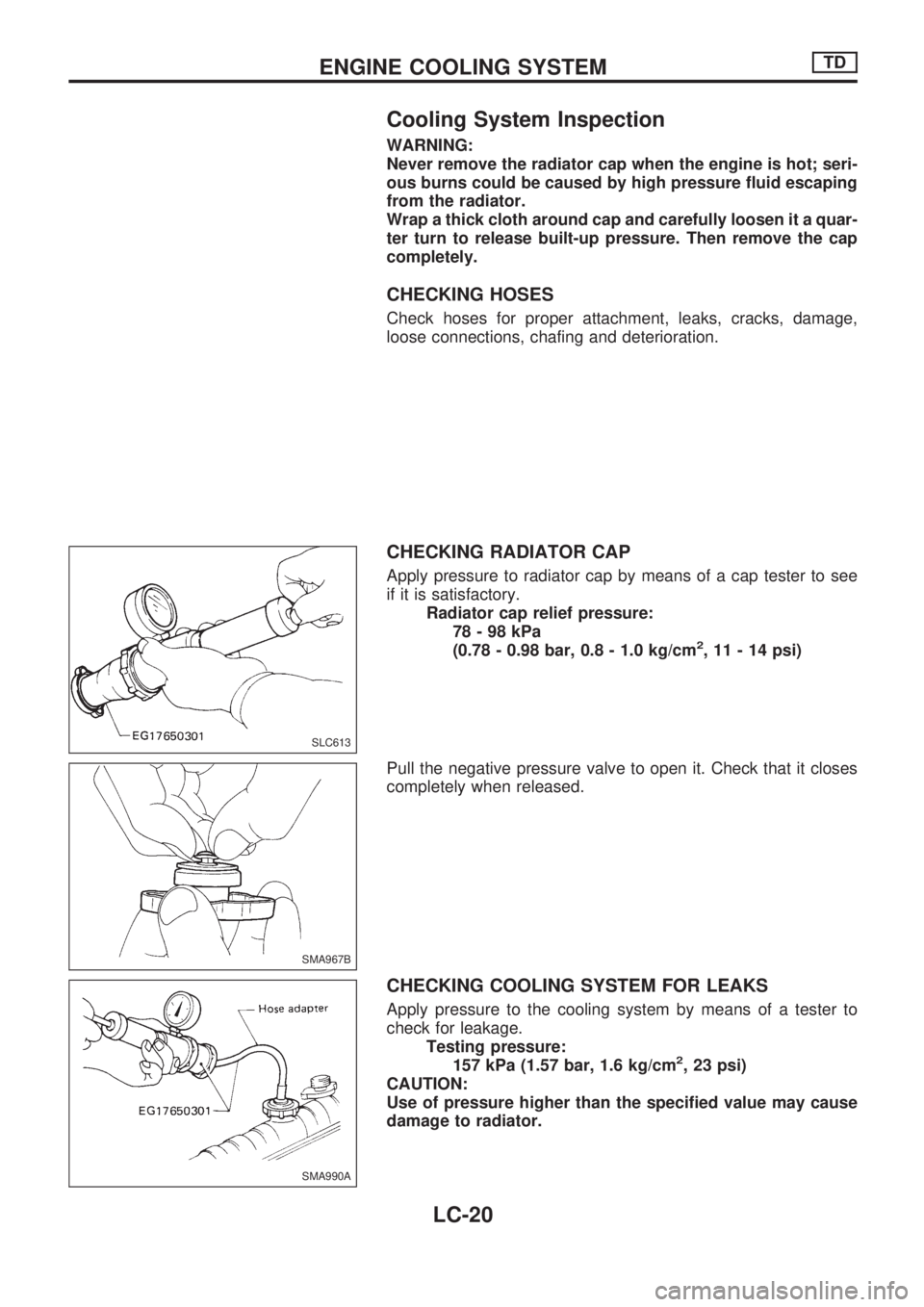Page 947 of 1659

INSPECTION
lCheck body assembly for rust or corrosion.
lCheck for rough operation due to excessive end play.
INSTALLATION
1. Use a scraper to remove liquid gasket from water pump.
lAlso remove traces of liquid gasket from mating surface
of cylinder block.
2. Apply a continuous bead of liquid gasket to mating surface
of water pump.
lUse Genuine Liquid Gasket or equivalent.
When filling radiator with coolant, refer to MA section
(``Changing Engine Coolant'', ``ENGINE MAINTENANCE'').
When installing drive belts, refer to MA section (``Checking
Drive Belts'').
Thermostat
lBe careful not to spill coolant over engine compartment.
Use a rag to absorb coolant.
REMOVAL
1. Drain coolant form engine. Refer to MA section (``Changing
Engine Coolant'', ``ENGINE MAINTENANCE'').
2. Remove air cleaner and air duct assembly.
3. Remove water hose from water inlet housing.
4. Remove water inlet housing, then take out thermostat.
INSPECTION
1. Check valve seating condition at normal room temperatures.
It should seat tightly.
2. Check valve opening temperature and valve lift.
Valve opening temperature ÉC (ÉF) 76.5 (170)
Valve lift mm/ÉC (in/ÉF) More than 8/90 (0.31/194)
3. Then check if valve closes at 5ÉC (9ÉF) below valve opening
temperature.
SLC738
SLC188A
SLC391AA
ALC061
SLC343
ENGINE COOLING SYSTEMKA
Water Pump (Cont'd)
LC-8
Page 948 of 1659

INSTALLATION
1. Use a scraper to remove old liquid gasket from water inlet.
lAlso remove traces of liquid gasket from mating surface
of front cover.
2. Apply a continuous bead of liquid gasket to mating surface
of water inlet.
lUse Genuine Liquid Gasket or equivalent.
3. Install thermostat with jiggle valve or air bleeder at upper
side.
4. Install water inlet housing.
5. Install water hose to water inlet housing.
6. Install air cleaner and air duct assembly.
7. Refill engine coolant. Refer to MA section (``Changing Engine
Coolant'', ``ENGINE MAINTENANCE'').
lAfter installation run engine for a few minutes, and
check for leaks.
Radiator
REMOVAL AND INSTALLATION
1. Drain coolant from radiator. Refer to MA section (``Changing
Engine Coolant'', ``ENGINE MAINTENANCE'').
2. Disconnect upper and lower radiator hoses.
3. Remove air cleaner and air duct assembly.
4. Remove lower radiator shroud.
5. Remove radiator shroud.
6. Disconnect coolant reservoir hose.
7. Remove radiator.
8. After replacing radiator, install all parts in reverse order of
removal.
9. Refill engine coolant. Refer to MA section (``Changing Engine
Coolant'', ``ENGINE MAINTENANCE'').
lAfter installation, run engine for a few minutes, and
check for leaks.
SLC824-A
SLC097
ENGINE COOLING SYSTEMKA
Thermostat (Cont'd)
LC-9
Page 950 of 1659
INSPECTION
Check fan coupling for rough operation, wobbling, oil leakage or
bent bimetal.
After assembly, verify the fan does not wobble or flap while the
engine is running.
WARNING:
lWhen the engine is running, keep hands and clothing
away from moving parts such as drive belts and fan.
Refilling engine coolant
For details on refilling engine coolant, refer to MA section
(``Changing Engine Coolant'', ``ENGINE MAINTENANCE'').
SLC072
SLC151B
ENGINE COOLING SYSTEMKA
Cooling Fan (Crankshaft driven) (Cont'd)
LC-11
Page 952 of 1659
Oil Pressure Check (On-vehicle service)
WARNING:
lBe careful not to burn yourself, as the engine and oil
may be hot.
lOil pressure check should be done in ``Neutral'' gear
position.
1. Check oil level.
2. Disconnect oil pressure switch harness connector.
3. Remove oil pressure switch.
4. Install pressure gauge and hose.
5. Start engine and warm it up to normal operating temperature.
6. Check oil pressure with engine running under no-load.
Engine speed
rpmApproximate discharge pressure
kPa (bar, kg/cm2, psi)
Idle speed More than 78 (0.78, 0.8, 11)
3,000294 - 392
(2.94 - 3.92, 3.0 - 4.0, 43 - 57)
If difference is extreme, check oil passage and oil pump for
oil leaks.
7. Install oil pressure switch with sealant.
Oil pressure switch:
:10-13Nzm (1.0 - 1.3 kg-m, 87 - 113 in-lb)
DLC013
DLC002
ENGINE LUBRICATION SYSTEMTD
LC-13
Page 953 of 1659
Oil Pump
OIL PUMP INSPECTION
1. Inspect pump body, gears and drive shaft for wear and dam-
age.
2. Using a feeler gauge and fuse wire, check the following
clearances.
Gear side clearance:
Less than 0.13 mm (0.0051 in)
Gear backlash:
Less than 0.43 mm (0.0169 in)
3. Measure inside diameter ``A'' of bushing.
A: 13.012 - 13.106 mm (0.5123 - 0.5160 in)
SLC020AB
SLC966
SLC967
SLC968
ENGINE LUBRICATION SYSTEMTD
LC-14
Page 955 of 1659
Oil Filter Bracket
OIL PUMP RELIEF VALVE INSPECTION
1. Visually inspect components for wear and damage.
2. Coat relief valve with engine oil and check that it falls
smoothly into the valve hole by its own weight.
If damaged, replace oil pump relief valve set.
OIL FILTER RELIEF VALVE INSPECTION
Inspect oil filter relief valve for rough movement and damage by
pushing the ball.
If damaged, replace oil filter bracket assembly.
DLC003
ENGINE LUBRICATION SYSTEMTD
LC-16
Page 956 of 1659
Oil Cooler
OIL COOLER RELIEF VALVE INSPECTION
Inspect oil cooler relief valve for movement, cracks and breaks
by pushing the ball.
If damaged, replace oil cooler relief valve set.
REGULATOR VALVE INSPECTION
1. Visually inspect components for wear and damage.
2. Coat regulator valve with engine oil and check that it falls
smoothly into the valve hole by its own weight.
If damaged, replace regulator valve set.
SLC141B
ENGINE LUBRICATION SYSTEMTD
LC-17
Page 959 of 1659

Cooling System Inspection
WARNING:
Never remove the radiator cap when the engine is hot; seri-
ous burns could be caused by high pressure fluid escaping
from the radiator.
Wrap a thick cloth around cap and carefully loosen it a quar-
ter turn to release built-up pressure. Then remove the cap
completely.
CHECKING HOSES
Check hoses for proper attachment, leaks, cracks, damage,
loose connections, chafing and deterioration.
CHECKING RADIATOR CAP
Apply pressure to radiator cap by means of a cap tester to see
if it is satisfactory.
Radiator cap relief pressure:
78-98kPa
(0.78 - 0.98 bar, 0.8 - 1.0 kg/cm
2, 11 - 14 psi)
Pull the negative pressure valve to open it. Check that it closes
completely when released.
CHECKING COOLING SYSTEM FOR LEAKS
Apply pressure to the cooling system by means of a tester to
check for leakage.
Testing pressure:
157 kPa (1.57 bar, 1.6 kg/cm
2, 23 psi)
CAUTION:
Use of pressure higher than the specified value may cause
damage to radiator.
SLC613
SMA967B
SMA990A
ENGINE COOLING SYSTEMTD
LC-20